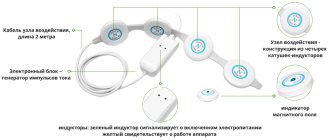How to overcome the disease?
The peculiarity of VSD is that it sometimes goes unnoticed for many years and is not treated, without causing dangerous health consequences. In the end, a person gets used to the fact that he often has a headache in the morning, and it is difficult to fall asleep in the evening; he considers it his peculiarity that his feet get cold in the summer, and allergies appear in the winter. In fact, all of these are symptoms of impaired regulation of autonomic functions that can be combated.
What is vegetative-vascular dystonia?
Vegetative-vascular dystonia (VSD)
) is a malfunction in the functioning of the whole organism. By and large, this is not a disease, but a malfunction of the autonomic nervous system, a violation of the regulation of the dynamic constancy of the internal environment of the body and the stability of its basic physiological functions: breathing, blood circulation, digestion, thermoregulation, metabolism, excretion, reproduction, etc. This is a functional failure of the body that can turn into disease.
VSD is a very common disease. About half of all women and a fifth of men are susceptible to autonomic dysfunction syndrome. Complaints can be very diverse: patients complain of weakness, pain in the heart area and under the left shoulder blade, headache, pressure surges and neurological disorders. If no measures are taken, the patient only gets worse. In the future, more serious surges in pressure, disruption of brain function and panic attacks are possible - acute stressful conditions characterized by a serious disturbance in a person’s mental state. If left untreated, functional disorders of VSD can cause more serious diseases, such as hypertension.
Quite often, vegetative-vascular dystonia is situational in nature: this means that an exacerbation of symptoms occurs against the background of stress, during weather changes, menstruation or other ordinary situations.
To date, doctors have described about 150 symptoms and 32 syndromes of clinical disorders with the diagnosis of “vegetative-vascular dystonia”. This is too much for an accurate diagnosis of any disease, and this is why diagnosing VSD is very difficult.
Many patients do not understand what serious consequences vegetative-vascular dystonia can lead to. Unfortunately, feeling unwell and having headaches is considered a “habitual” occurrence that can be alleviated with painkillers.
The availability of medications does its job: it’s easier to go to the pharmacy and relieve pain with pills, but medications only eliminate the symptoms of VSD and have nothing to do with treatment.
The mechanism of development of vegetative-vascular dystonia is as follows: in a normal state, the autonomic nervous system regulates the activity of internal organs, ensuring their adequate response to processes occurring in the body. In turn, the activity of the human autonomic nervous system is regulated by two subsystems: parasympathetic and sympathetic.
The parasympathetic subsystem is responsible for sleep and restoration of the body's strength, and the sympathetic subsystem is responsible for the period of wakefulness. Their work “alternates,” allowing a person to expend energy during the day and recover at night, during sleep and rest. The systems are closely connected to the brain and spinal cord and their failure affects the activity of the entire nervous system. The disruption of the relationship between these subsystems and the body’s incorrect response to natural processes is called vegetative-vascular dystonia. Since we are talking about malfunctions of the nervous system, VSD is very difficult to diagnose. The patient visits several specialists without success, but his condition continues to worsen. At the same time, the test results or cardiogram are in perfect order, but the patient feels worse and worse.
Treatment of vegetative-vascular dystonia
If treatment is started in a timely manner, the result in most cases will be positive. However, it may take several months. The duration of therapy directly depends on the form of vegetative-vascular dystonia and varies between 4–10 months. It is impossible to prescribe a universal remedy for VSD that will definitely help overcome the pathology.
The main role in the fight against vegetative-vascular dystonia is played by a healthy lifestyle, feasible physical activity and lack of stress. In addition, to achieve results, you need to give up smoking and drinking alcohol, normalize your work and rest schedule, adhere to proper nutrition, diversifying your diet with vegetables, fruits, nuts and dairy products.
What is prescribed for VSD? Treatment of vegetative-vascular dystonia is a whole range of measures, which may include the following:
- diet;
- taking medications;
- physical therapy;
- breathing exercises;
- acupuncture;
- massage;
- balneotherapy;
- phototherapy;
- psychotherapy;
- physiotherapeutic procedures (massage, breathing exercises, etc.).
There are a lot of drugs prescribed for VSD. Their choice depends on the symptoms of the pathology, the person’s health status, age and other factors. Therefore, only a doctor can tell you what to take for VSD. For each patient, the doctor develops an individual treatment regimen (based on the clinical picture), which may include the following groups of drugs:
- soothing herbal remedies;
- antidepressants;
- tranquilizers and anxiolytics;
- nootropics;
- vascular drugs;
- psychotropic drugs;
- adaptogens, etc.
Symptoms of vegetative-vascular dystonia?
The symptoms of autonomic dysfunction are very diverse: the patient’s condition is characterized by a variety of symptom complexes. Symptoms appear against the background of physical and mental stress, family worries, problems at work and general weakness of the body. Most often, VSD is characterized by vague pain in the heart, sweating, rapid heartbeat, a feeling of shortness of breath and fluctuations in blood pressure. The painful condition may be accompanied by fear, weakness, trembling in the limbs, slight dizziness, irritability, anxiety, tinnitus and decreased appetite - even fainting and sudden emotional swings. These symptoms can be the cause of a variety of diseases. The diagnosis of VSD is made by excluding those diseases that the patient complains of. If the patient’s complaints are not confirmed by the examination results, the doctor excludes a specific disease and continues to look for the cause of the ailment. If consistent work based on the patient’s complaints and examination results does not allow one to draw a specific conclusion about the causes of the disease, the doctor makes a diagnosis of VSD. One of the most well-known symptoms of VSD is meteorological dependence - the patient feels unwell when the weather changes.
Diagnostic methods
Vegetative-vascular dystonia is an exception diagnosis. This means that it is placed after a complete examination of the cardiovascular and nervous systems, if no abnormalities are found in them.
For diagnosis, you need to contact a general practitioner, who, if necessary, will refer you to a cardiologist, neurologist or endocrinologist. In order for a doctor to make an accurate diagnosis, it is necessary to accurately describe the symptoms and the time of their onset. The therapist will definitely clarify whether the patient drinks alcohol, nicotine, how often he drinks coffee and what daily routine he follows. This data is necessary to correctly make recommendations for the treatment of the disease.
To diagnose vegetative-vascular dystonia, the following methods are used:
- laboratory diagnostics - general blood and urine analysis without specific changes, in biochemical analysis the lipid ratio may be disturbed;
- blood test for hormones - a study of thyroid hormones is indicative; if they increase, tachycardia and weight loss may be observed;
- ECG - changes are not typical for VSD, sometimes it is possible to record tachycardia, single extrasystoles, but there are no signs of severe conduction disturbances in the heart;
- EEG - electroencephalogram can reveal slight deviations in the conduction of impulses in the brain;
- Ultrasound of internal organs - examination of the abdominal cavity in case of complaints of indigestion, examination of the heart, kidneys, and pelvic organs in women.
Dysfunction of the nervous system is not accompanied by damage to internal organs; most indicators are within the normal range, despite complaints of poor health.
Types of vegetative-vascular dystonia
Vegetative-vascular dystonia is manifested by many symptoms, varying in nature and intensity.
Based on patient complaints and doctors’ experience, several types of vegetative-vascular dystonia can be classified, among which the following types are the most common:
VSD of mixed type:
the patient complains of headache, nervousness, anxiety and fear, dizziness and changes in heart rate.
VSD according to cardiac type:
the predominance of complaints of pain in the area of the heart and left shoulder blade, rapid heartbeat. In this case, blood pressure can deviate either upward or downward, or be stable.
VSD according to the vagotonic type:
causeless abdominal pain, nausea, lack of appetite, digestive problems. The patient may complain of insomnia, increased swelling, fatigue, sweating and psychological sensitivity.
VSD of the hypertensive type:
one of the most common types, when the disease occurs with high blood pressure. Most often, the patient complains of headaches, nausea and dizziness.
VSD of hypotonic type:
manifests itself in the form of weakness, increased sweating, and is characterized by decreased ability to work. In this case, blood pressure is steadily reduced.
Each type of VSD has its own symptoms of the disease and their list is quite extensive. To one degree or another, the initial signs of vegetative-vascular dystonia are present in every person and most people simply do not pay attention to them. If you have a headache, you take medicine, but the true cause of the ailment remains unclear.
This is the main danger of vegetative-vascular dystonia. Lack of proper treatment and self-medication leads to the progression of VSD: gradually the whole body is involved in the process, and if no action is taken, the disease has consequences on the internal organs. Over time, it becomes more and more difficult for a person to maintain a comfortable rhythm of life: the manifestations of the disease become more acute, and more and more medications are required to relieve symptoms.
In an advanced stage, vegetative-vascular dystonia leads to kidney problems, varicose veins, thrombosis, as well as a significant increase in the risk of heart attack. In the chronic stage, VSD leads to complete disability and causes serious mental illness.
Systematizing all cases, doctors conclude that the following factors can cause the disease:
- Hereditary constitutional factor: the likelihood of VSD increases if one of the parents suffers from this disease. In addition, those people who grew up in single-parent families, or where they were raised in an environment of frequent quarrels and scandals, are more susceptible to the disease.
- Psychophysiological changes that can occur due to stress, heavy physical or intellectual work. There is a high probability of the occurrence and development of VSD against the background of viral infections, alcohol abuse and smoking. Chronic stress, alcohol abuse and smoking contribute to the deterioration and progression of the condition. The most likely causes of vegetative-vascular dystonia may be the inability to rest and relax after hard work, a sedentary lifestyle or a violation of the daily routine. We can draw the following conclusion: everything that weakens the immune system and does not benefit the body can cause the development of vegetative-vascular dystonia.
- Hormonal changes: VSD can occur during puberty and during menstruation.
- Organic somatic diseases: the disease is aggravated by diseases of the heart and blood vessels, respiratory system, liver dysfunction, gastrointestinal tract and processes affecting mental activity; VSD can occur against the background of viral infections and disorders of the musculoskeletal system - problems with the spine often coexist with autonomic dysfunction.
- Diseases of the nervous system: VSD accompanies many diseases of the nervous system.
- Occupational diseases: physical factors of the working environment - electromagnetic radiation, increased noise levels, foreign odors, etc. – can cause VSD.
- Neuroses: one of the most common factors causing the manifestation of autonomic dysfunction syndrome.
- Mental illnesses: cause emotional and personal disorders, which also provoke the onset and course of VSD.
From the above it is clear that there are many reasons for the occurrence of vegetative-vascular dystonia.
Causes of vegetative-vascular dystonia
The main causes of vegetative-vascular dystonia include the following.
- Prolonged stress.
- Mental trauma.
- Physical overexertion.
- Bad habits (smoking, drinking alcohol).
- Negative environmental factors.
- Hereditary predisposition.
- Psycho-emotional overload.
- Sudden and significant changes in environmental conditions.
- Mental fatigue.
- Age-related hormonal changes.
- Severe intoxication.
In addition to the listed reasons that have a direct impact on the appearance of vegetative-vascular dystonia, there are a number of factors that themselves cannot cause VSD, but reveal a predisposition to it. The longer and stronger their exposure, the higher the likelihood of pathology occurring.
Violation of the vegetative functions of the body is promoted by:
- smoking;
- frequent and prolonged work at the computer;
- frequent abuse of alcoholic beverages;
- lack of sleep;
- uncontrolled medication use;
- frequent consumption of very spicy foods.
How to treat vegetative-vascular dystonia with the ALMAG-01 device
IMPORTANT: the ALMAG-01 device can only be used for the treatment of VSD due to hypertension. Treatment must begin after the acute phase of the vegetative crisis.
THE DESIGN OF ALMAG-01 INCLUDES THE FOLLOWING ELEMENTS:
Physiotherapeutic procedures with the ALMAG-01 device are carried out once a day. The standard course of treatment lasts three weeks: after every six days, a one-day break is required. The course of treatment is 18 procedures. A repeated course can be carried out after 30-40 days, and a maintenance course - 3-4 months after completion of treatment.
The treatment procedure is simple and does not require special knowledge. Inductor coils are sequentially applied to the projection area of the adrenal glands and the collar zone, and the exposure time is set according to a table developed by specialists.
Fortunately, vegetative-vascular dystonia is a curable disease. To do this, it is necessary not only to undergo treatment, but also to change your lifestyle, reconsidering your views on your daily routine, rest and physical activity.
Treatment of VSD symptoms in adults
Treatment of VSD symptoms is carried out individually in each case. They use sedatives, antidepressants, tranquilizers, other medications, and general restorative treatment.
You should not self-medicate. See your doctor. Symptoms of vegetative-vascular dystonia do not lead to serious complications, but cause a lot of problems and reduce performance. They may be hiding a more serious illness.
Make an appointment with a neurologist at the medical center International Clinic Medica24 - at any time of the day
In each case, treatment for vegetative-vascular dystonia is selected individually, after examination by a doctor and a comprehensive examination. If the symptoms of VSD are caused by another disease, it must be treated as well.
Tired of going to doctors? Do you undergo one examination after another, each time it turns out that everything is normal, but your symptoms continue to bother you? Visit a neurologist at the Medical Center International Clinic Medica24. Here you will be given a reliable diagnosis and prescribed the correct treatment. Call us any day of the week, at any time: +7 (495) 230-00-01
The causes of VSD in adults and children have not been fully established. It is believed that the disease occurs under the influence of various factors; in different people their effects are expressed to varying degrees, and they are combined in different ways. That is why the manifestations of vegetative-vascular dystonia are so diverse; it is difficult to find two patients in whom the disease would proceed in exactly the same way.
A doctor can judge the causes of VSD only approximately; it is much more important to correctly assess the symptoms and prescribe effective treatment.
Therapeutic effect of ALMAG-01 in the treatment of VSD
The running pulsed magnetic field of the ALMAG-01 device improves blood circulation in the affected area, increases the activity of cells and the endocrine system, which has a positive effect on the production of hormones and enzymes. And this, in turn, allows you to normalize the functions of the human cardiovascular and nervous systems. The device has a general calming effect.
The use of the ALMAG-01 device for the treatment of VSD can significantly reduce the intake of medications, or even do without their use, and prevent the development of hypertension.
Exposure to the zone of a traveling pulsed magnetic field reduces vascular tone, the opened capillaries begin to let more blood through and trigger the mechanism for restoring metabolic processes.
The magnetic pulses of the device penetrate deep into the tissue and are able to have a complex effect on all tissue capillaries. Normalizing blood circulation and metabolic processes can improve the quality of sleep, the general well-being of the patient and relieve the main symptoms characteristic of attacks of VSD.
In the ALMAG-01 device there is no problem of the patient getting used to the physiological procedure: sequential activation of the field generators allows you to create the effect of a “running” field, and the constant change in the intensity of the inductor coils does not allow the body to get used to the therapeutic effect.
How to prevent or stop an attack of VSD
If you want to prevent an attack of VSD or get out of it with the least loss to the body, you need to analyze and, if possible, eliminate the conditions that provoke the development of this condition.
If the cause is fear, severe emotional shock or another external irritant, you need to try to take control of your emotions, think about something distracted, close your eyes, massage your eyelids. To stop an attack of VSD, it is also worth providing an influx of fresh air (open a window, unbutton a collar, or get rid of items of clothing that impede breathing). To improve cerebral circulation, you should lie down or at least take a comfortable sitting position.
To cope with an attack of migraine-like VSD, you need to go to a quiet place where there is no bright light. If your blood pressure increases or decreases, it is recommended to take the appropriate medication. A hot foot bath or a warm blanket will help overcome chills. In addition, at the first sign of an approaching panic attack, it is recommended to eat something sweet and drink a glass of water in slow sips.
Since it is not always possible to relieve an attack of VSD on your own, experts recommend taking a sedative.
Without professional medical help, panic attacks can become more frequent, gaining strength each time. Therefore, people prone to repeated exacerbations should definitely visit a neurologist. An experienced doctor will be able to advise how to get rid of an attack of VSD, select the optimal treatment regimen and tell you what to do during the next vegetative-vascular crisis.
Advantages of the ALMAG-01 device in the treatment of VSD
- ALMAG-01 improves microcirculation and normalizes blood pressure. Even at the initial stage of treatment, the patient's increased vascular tone decreases and blood circulation improves.
- Eliminates the main cause of VSD - normalizes a person’s mental state.
- By reducing the sensitivity of peripheral nerve receptors, the device has a calming effect and restores sleep quality.
- Treatment allows you to normalize blood pressure, and in the case of tachycardia, reduce the heart rate.
- The course of treatment does not require special knowledge and can be carried out by the patient independently, at home.
- The device is able to enhance the effect of medications used and even completely eliminate them.
Main causes of VSD in adults
Representatives of the fair sex suffer from this disease more often, however, the causes of vegetative-vascular dystonia in women and men do not differ:
Conditions that predispose to vegetative-vascular dystonia (increase the likelihood of developing VSD):
- Features of the structure and functioning of the body;
- Features of personality, human psychology;
- Living in unfavorable social and economic conditions;
- Hormonal changes (puberty in adolescents, menopause in women).
Factors that can provoke the occurrence of VSD:
- Severe, chronic stress, nervous shock;
- Overwork;
- Exposure to radiation;
- Passion for alcohol;
- Pregnancy;
- Abortion;
- Ovarian dysfunction in women;
- Chronic inflammatory diseases;
- Exacerbations of diseases.
Take care of yourself, book a consultation now
Message sent!
expect a call, we will contact you shortly







